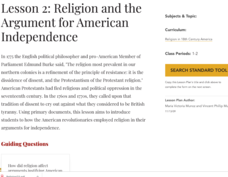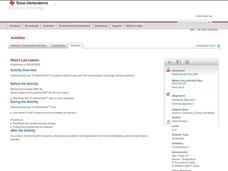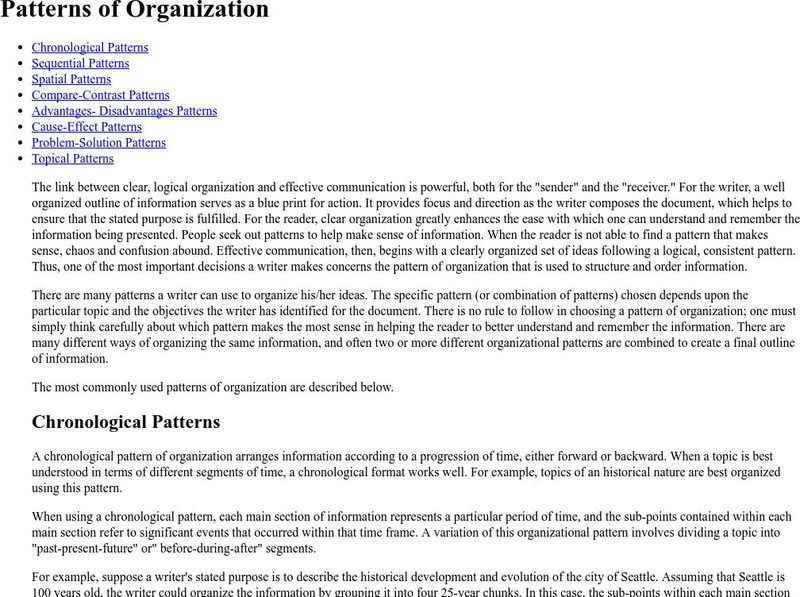National Endowment for the Humanities
Lesson 2: Religion and the Argument for American Independence
Young scholars examine how religion affected arguments justifying American independence. They read and analyze primary source documents, and write an essay analyzing how Americans used religious arguments to justify revolution against a...
National Endowment for the Humanities
Lesson 1: The First Great Awakening
High schoolers examine the First Great Awakening and how it affected religious belief in colonial America. They read and analyze primary source documents, explore various websites, and write a five-paragraph essay examining the beliefs...
Children’s Hospital of Philadelphia
Case Studies: Influenza and HIV
Stop infection spread. Pupils participate in an activity to model infections and replications of viruses. Within the activity, scholars see that viruses may end up with genetic variation and connect that to how some forms of the flu are...
Curated OER
Centers of the Storm: The Lyceum and the Circle at the University of Mississippi
Greek Revival architecture and the Civil Rights Movement? Sure! Examine how the Lyceum and Circle, two historic buildings located on the campus of the University of Mississippi, relate to integration and the 1962 riot on the university...
National Endowment for the Humanities
The Debate in the United States over the League of Nations: Five Camps: From Voices of Consent to Voices of Dissent
Learners explore and discuss Woodrow Wilson's concepts for peace and the League of Nations. They understand efforts made to foster American support for the League and discuss the opposition shown in the Senate.
Curated OER
Hess's Law
Pupils solve chemical equations. In this chemistry lesson, they balance chemical equations after completing a lab. They can use a TI for this assignment.
Curated OER
Energy Content of Foods
Learners collect data, organize and analyze the data and compare it to real life scenarios. This assignment requires two class periods.
Curated OER
Introduction to Electric Circuits
High schoolers explore using a circuit board in this physics lesson. They will analyze current and battery set up on a circuit board. Teachers check the board before the students experiment.
Curated OER
Keep it Bottled Up: Linear Rates of Pressure Increase
Pupils explore linear functions in this lesson when they collect and analyze data as a chemical reaction proceeds. Learners record pressure versus time data and model the data as a linear function. They also examine the concept of slope...
Curated OER
Falling Objects
High schoolers examine the velocities of two different falling objects. They produce distance vs. time and velocity vs. time graphs using a Motion Detector and a CBL 2 to collect experimental data. Learners analyze and interpret the...
Curated OER
When the Snow is as High as an Elephant
High schoolers study the concept of mean values using a data plot. Learners enter the given data in the activity to create their data table. They use the data table to calculate the mean of the snowfall percentage provided in the...
Curated OER
Corn-Crop is a Bin-Buster
Learners calculate percent change and create lists of data. They enter the corresponding bushels of corn measured in billions to their list and display, then convert the acres into scientific notation and use the value on the home screen...
Curated OER
Angling for Distance
Explore the concept of projectile distance through determining the angle that will provide the maximum distance of a launched projectile. Students launch baseballs on a football field and video tape the path of the ball.
National Endowment for the Humanities
Slavery and the American Founding: The "Inconsistency Not to Be Excused"
High schoolers examine slavery in the revolutionary and colonial eras of the United States. In this slavery lesson, students investigate the presence of slavery in early America, the language of the Constitution, and the intent of the...
National Endowment for the Humanities
Lesson 3: Religion and the Fight for American Independence
Pupils explore the role religion played in the American Revolutionary War. Using primary documents and writing exercises, high schoolers understand how religion was used in support of the war efforts and how specific religious groups...
National Endowment for the Humanities
Lesson 2: The Debate in Congress on the Sedition Act
Pupils research and discuss the provisions in the Constitution that supported the arguments for and against the Sedition Act. They articulate objections to and arguments in favor of the Sedition Act.
National Endowment for the Humanities
Chinua Achebe's Things Fall Apart: Oral and Literary Strategies
Readers are first introduced to Chinua Achebe's Things Fall Apart by making a map of Africa. They will better understand the novel's historical and literary contexts, European and African literary traditions, and how historical events...
Buck Institute
Pbl Works: Presentation Rubric Grades 9 12 (Non Ccss)
[Free Registration/Login Required] This rubric helps teachers guide students in grades 9-12 in making effective presentations in a project, and it can be used to assess their performance. Alignment with CCSS is not noted. It describes an...
Buck Institute
Pbl Works: 9 12 Presentation Rubric (Ccss Aligned)
[Free Registration/Login Required] This rubric helps teachers guide students in grades 9-12 in making effective presentations in a project, and it can be used to assess their performance. Alignment with CC ELA standards for Speaking and...
ReadWriteThink
Read Write Think: Venn Diagram, 2 Circles
A printable Venn diagram to use when comparing and contrasting two things or topics. Directions on how to use this graphic organizer as well as lists of teaching ideas and related resources are also provided.
Other
Indiana University of Pennsylvania: Writing Center: Structure and Organization
This Indiana University of Pennsylvania Writing Center site provides resources to help students organize the content of their essays. Resources to help students with outlining content and incorporating transition words are provided.
Sophia Learning
Sophia: Descriptive Papers: Organization
This slideshow lesson discusses the organization of descriptive papers. It reviews descriptive papers, lists the three most common organizational patterns: least to greatest, greatest to least, and chronological. Determining which order...
Annenberg Foundation
Annenberg Learner: Build a Rubric
Rubrics provide students with clear expectations and consistent feedback. Build a customizable rubric that can be used for any writing activity your class might be completing.
University of Washington
University of Washington: Patterns of Organization
In addition to defining and describing various patterns of text organization, this website provides outlines illustrating each pattern. RI.11-12.3 Text development
























